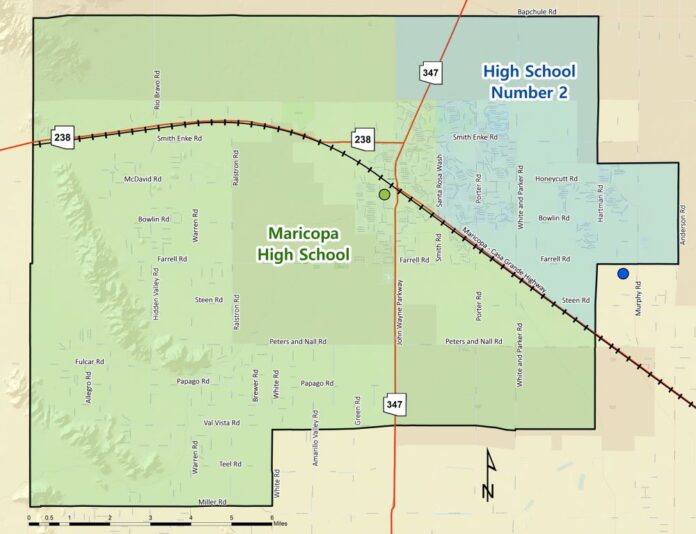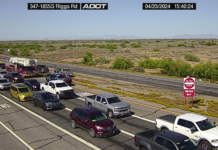
The committee tabbed by the Maricopa Unified School District to recommend attendance borders for the city’s second high school made its initial recommendations Wednesday night, sharing four separate plans and recommending one.
The committee, led by Dr. Tracey Pastor, the district’s Director of Administrative Services, was charged with identifying the attendance area borders for the city’s two high schools. Pastor said the committee had one primary goal.
“Our primary goal was to come up with a map that would go into effect for the 2022-23 school year and would designate the area for both high schools for MUSD,” Pastor said, “Keep in mind that open enrollment is always an option and that students are not limited to attending the neighborhood school designated for them to attend.”
The boundary committee recommended a plan that will have students in the northeast portion of the city as the primary base of the new high school’s population.
Pastor outlined several of the key elements the committee considered when evaluating various attendance boundaries.
“One of the keys was maintaining the diversity that we have in our schools,” she said. “We considered convenience for families. Of course, transportation implications were very important. We considered our feeder schools. Keeping neighborhoods intact was high on our list of priorities whenever possible. And of course, just so important for everything that we do is the student culture, and that we ultimately had something that was easy to comprehend to communicate to families as well.”
However, the plan submitted did not accomplish one of those goals. Residents of Rancho El Dorado will see families west of the Santa Rosa Wash attending Maricopa High School and those east of the wash going to the new school.
Rick Brammer of Applied Economics, a consultant to MUSD on the boundary issue, explained the rationale for the split.
Brammer said two of the initial plans his company provided in order to spur discussion had the new school’s boundary extending south of the Union Pacific Railroad tracks, keeping a primarily east-west split in the district. He said that approach created student population numbers that well balanced both now and extending out 10 years.
However, he said after meeting with the boundary committee and MUSD Transportation Director Sergio Pulido, it was apparent that splitting communities and having students having to cross the railroad tracks on roads away from the overpass was a bad idea.
Given that, the committee needed to find additional students for the new school. To do so, they were forced to deviate from their initial plan not to split communities.
“Instead of pushing and finding more space south of the railroad tracks, to looking at, even though it was in violation of one of our standards, to break Ranch El Dorado at Santa Rosa Wash,” Brammer said. “So, you’ll see that’s basically where we found the number of students to put into the second high school.”
The full borders of the attendance area are (see the attached map for details):
- The western border of the attendance area is the Santa Rosa Wash;
- The southern border is the Union Pacific Railroad tracks;
- The eastern border is Hartman Road, with the exception of the area around Tortosa, where it extends east to Anderson Road;
- On the north, the area extends to the Gila River Indian Community
A fourth alternative also was presented that looked at using the existing middle school boundaries and having a uniform feeder system in which all the students from a given middle school would attend one high school. However, Brammer said that proposal presented long-term problems in that it would make the new high school too large, leaving no breathing room in terms of balancing future attendance.
Brammer said the goal of the group is to look at the numbers both now and into the future.
“My goal is to provide information to the community and allow us to make a decision that is good not only for the here and now but that will hopefully stand for many years in the future,” he said. “Because it’s obviously a lot more painful to revise attendance areas as we go forward.”

![Maricopa’s ‘TikTok Rizz Party,’ explained One of several flyers for a "TikTok rizz party" is taped to a door in the Maricopa Business Center along Honeycutt Road on April 23, 2024. [Monica D. Spencer]](https://www.inmaricopa.com/wp-content/uploads/2024/04/spencer-042324-tiktok-rizz-party-flyer-web-218x150.jpg)






![Who’s the Best Mom InMaricopa? Nominate now! Marlene Marshall, Christina Olivares, and Meghan Bremer. [Bryan Mordt]](https://www.inmaricopa.com/wp-content/uploads/2023/05/BCM_8465-218x150.jpg)




![Alleged car thief released without charges Phoenix police stop a stolen vehicle on April 20, 2024. [Facebook]](https://www.inmaricopa.com/wp-content/uploads/2024/04/IMG_5040-218x150.jpg)
![Maricopa’s ‘TikTok Rizz Party,’ explained One of several flyers for a "TikTok rizz party" is taped to a door in the Maricopa Business Center along Honeycutt Road on April 23, 2024. [Monica D. Spencer]](https://www.inmaricopa.com/wp-content/uploads/2024/04/spencer-042324-tiktok-rizz-party-flyer-web-100x70.jpg)


